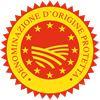Description
Salame Piacentino PDO is a large-grained stuffed charcuterie product, obtained from the lean and fatty parts of pigs belonging to the Large White, Italian Landrace and Duroc breeds, or other breeds compatible with the Italian heavy pig.
Production Area
The production area of Salame Piacentino PDO is within the areas of the Province of Piacenza located up to 900 m.a.s.l., in the Emilia-Romagna region. The pigs used for production must be born, raised and slaughtered in the regions of Lombardy and Emilia-Romagna.
Production Method
The lean part is selected, excluding meat cuts from the head; lard, throat and parts of the underbelly without soft fat are used for the fat part (10% to 30 %). The meat is minced in a mincer with large holes (diameter of over 10 mm) and seasoned with salt, pepper, nutmeg, garlic, wine and sugar. The meat mixture is inserted into a pork casing, tied with string, pierced and dried in a suitable environment. The curing process takes place under temperature and humidity-controlled conditions for a period of at least 45 days, starting from the date of salting. Ventilation and exposure to light and natural humidity are permitted during the curing stage.
Appearance and Flavour
Salame Piacentino PDO has a cylindrical shape and a weight ranging from 400 g to 1 kg. When cut, the slice is vivid red, interlaced with pinkish-white lard fat. The taste is sweet and delicate, and it has a characteristic fragrant aroma that is influenced by the length of time the product is cured for.
History
The first traces of pig farming in the production area of Salame Piacentino PDO date back to one millennium BC. Evidence was subsequently found in Roman civilization, with archaeological finds such as a bronze talisman-pendant showing a small pig. Depictions of this animal can also be found in the Abbey of San Colombano a Bobbio, in Val Trebbia (Piacenza), where there is a 12th century mosaic portraying the “sacred” rite of pig slaughtering. At the beginning of the 15th century, Milanese and Lombardy vendors were already able to distinguish Piacenza charcuterie products from those coming from other places in the Padan Plain, qualifying them as “roba de Piaseinsa” (stuff from Piacenza). In the early decades of the 18th century, Piacenza charcuterie products were also appreciated in elite French and Spanish environments, thanks to Cardinal Giulio Alberoni, a skilful diplomat from Piacenza. During the last century, the local processing of meat started to become semi-industrial, however, notwithstanding the passing of time and progress in technology, companies continue to produce this product with traditional methods linked to customs passed down from generation to generation.
Gastronomy
The best way to conserve Salame Piacentino PDO is to completely remove the external casing and wrap it in a slightly damp cloth. It can then be kept in the refrigerator for up to 15 days. In order to obtain a compact slice, it is best to cut the salami diagonally while still cold; it is best eaten when it reaches a temperature of 10°C. It makes an excellent starter, served with traditional fried gnocchi or fresh figs. It can also be used as an ingredient in many local traditional dishes. It pairs very nicely with Colli Piacentini PDO wines.
Marketing
The product is marketed as Salame Piacentino PDO. It is sold unpackaged, vacuum-packed or in modified atmosphere packaging, whole, in pieces or sliced.
Distinctive Features
Salame Piacentino PDO’s distinctive quality is the result of master charcutiers’ ability to artfully amalgamate the meats and seasoning.




























